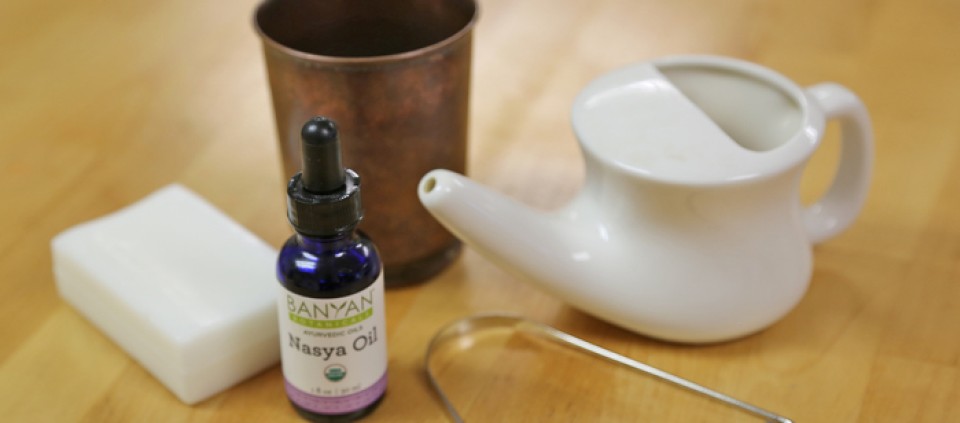The Ayurvedic Bathroom: Stocking up for Self-Care

Ready to make your bathroom an Ayurvedic oasis? Here’s how to boost your self-care game with nourishing products inspired by yoga’s sister science.
You can find the products I mention below, and lots more, at my favorite online Ayurvedic spots for high-quality products: Banyan Botanicals, LifeSpa, and the Himalayan Institute.
Ayurvedic Soap: Make your shower a mini spa experience with purifying spices and delicious scents. Chemical-free soaps with a coconut oil base clean and nourish your skin. Organic herbs infused into the soap support individual needs:
- Neem soap: Try this traditional blend for its deeply cleansing and cooling effects—excellent for easily inflamed skin and great for fiery pitta types. It’s my daily choice.
- Lavender soap: Lather up with this soothing, calming blend when you’re feeling exhausted, spun out, or need a good night’s sleep. Generally considered tri-doshic (suitable for all three doshas—vata, kapha, and pitta), lavender is especially excellent for vata types and during particularly stressful times.
- Eucalyptus soap: Sleepy-eyed and sluggish in the morning? A shower with this mind-stimulating herb will give you some get-up-and-go. Eucalyptus is great for kapha types, eases sinus and lung congestion, and helps anytime you need an invigorating little kick.
Neti Stick: Instead of using a neti pot, try a little blast of invigorating aromatherapy. A few deep breaths of the lavender, peppermint, and eucalyptus blend open the channels right up. Inexpensive and incredibly long-lasting, Neti Sticks are an Ayurvedic self-care gem—I keep one in the bathroom, the car, my office desk, and my purse. Hygiene bonus—the nasal insertion cap comes off easily for regular cleaning, so germs don’t collect.
Copper Cup: Be honest, is there a questionably clean drinking cup that lives in your bathroom? Ayurveda has kept things clean for millennia thanks to the antimicrobial properties of copper—it can destroy bacteria. A great investment for hygiene and health. An Ayurvedic tip: fill with fresh water before bed and drink upon waking to support cleanliness, hydration, and—according to the classic texts—dosha-balancing.
Tongue Scraper: Brushing the tongue with a toothbrush just moves the gunk around. Start the day by gently scraping toxins off the tongue with a metal tongue scraper to clean the sense organ and freshen breath. Copper is classically used for its antimicrobial properties (see above), but stainless steel is also bacteria resistant. A simple yet incredibly valuable self-care practice, tongue scraping is a staple in Ayurvedic hygiene routines.
Garshana Gloves: Scrub off dead skin, stimulate lymphatic draining, improve circulation, and enhance the skin’s luster with an exfoliating dry massage using raw silk gloves. Ayurveda recommends a brief, brisk, full-body scrub before hydrating the skin with abhyanga oil. Don’t over-exfoliate in the dry winter season (vata)—limit to once or twice per week. But, in the damp spring season (kapha), kick up the exfoliation massage to several times per week to enhance the soft, supple radiance of the body’s largest organ.
Neti Pot: If you’ve never tried this wonderful sinus-cleansing practice of pouring warm salt water into the nose, pick up a new neti pot (ceramic or metal are most common and easiest to care for and sterilize) and read the instructions and precautions carefully (avoid during sinus infections; recent eye, ear, or nose surgery; bloody nose; deviated septum, etc.). Only use distilled or purified water, to ensure that no bacteria get into the sinuses. Many find neti helpful for removing sinus congestion, preventing sinus infections, and reducing seasonal allergies. This is a classic Ayurvedic self-care technique traditionally recommended for the morning routine.
- Neti Salt: The sinuses are sensitive, so only use fine salt specifically intended for the neti pot. Experiment with the perfect amount for you—too little and the salt water won’t cleanse, too much and it will burn. Take it slow and try differing amounts.
- Nasya Oil: After the channels have been cleansed by the neti, wait 30 to 60 minutes for the passageways to dry, then add a drop or two of nasya oil in each nostril to rehydrate the mucus membranes. Nasya oil is infused with herbs specifically chosen for the sensitive nasal passageways, so only use nasya oil in the nose. It has traditionally been part of the neti practice, but somehow the two got separated when neti pots were introduced in the West; Ayurveda would consider the process incomplete without the nasya oil. For invigoration, try a nasya oil with eucalyptus or mint. For a calming effect, try one with lavender.
There’s so much more to try—Ayurvedic toothpaste, oil pulling, abhyanga oil, dosha-balancing candles, and more—so experiment and have fun!
© Kripalu Center for Yoga & Health. All rights reserved. To request permission to reprint, please email editor@kripalu.org.
Larissa Hall Carlson, E-RYT 500, MA, 20-year Kripalu faculy and former Dean of the Kripalu School of Ayurveda, guides retreats, directs trainings, and provides Ayurvedic consultations across the country.
Full Bio and Programs